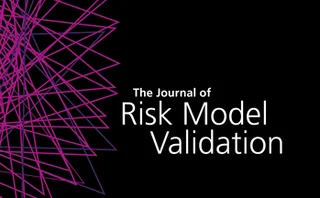Credit risk
Which EU banks hold the most SME exposures?
Danske Bank, Crédit Agricole, Group BPCE lead the field
UK banks took £2bn of loan-loss provisions in Q3
Barclays and HSBC increased reserves the most out of the top lenders
Lloyds lightens 2020 ECL forecast, but projects a gloomier 2021
UK banks expects full-year loan-loss amounts to come hit lower end of £4.5 billion–5.5 billion range
Model tweaks, asset cull helped Credit Suisse cut RWAs in Q3
Model updates took Sfr 2.5 billion off its credit RWA total
US election scenarios: meltdown fears if poll contested
Crowdsourced election scenarios show sharp falls and correlation breaks if Trump challenges results
IFRS 9 product of the year: AxiomSL
Asia Risk Technology Awards 2020
At Santander, Covid relief for €75bn of loans expired through Q3
Sixteen per cent of loans coming out of payment holidays have experienced a fall in creditworthiness
FX headwinds cancel out HSBC’s Q3 RWAs cut
Portfolio reductions reaped $10.8 billion of RWA savings
Barclays’ RWAs shrank on Q3 tailwinds, but loan failures loom
Decline in loan creditworthiness has added £9.8 billion to RWAs year-to-date
A FAVAR modeling approach to credit risk stress testing and its application to the Hong Kong banking industry
In this paper, a credit risk stress testing model based on the factor-augmented vector autoregressive (FAVAR) approach is proposed to project credit risk loss under stressed scenarios.
Covid policy risk hangs over bank stress tests
Banks and regulators are second-guessing the policy response to new outbreaks
Systemic US banks put aside $5bn for credit losses in Q3
Citi put aside $2.3 billion in Q3, the most of the top lenders
Credit exposure under the new standardized approach for counterparty credit risk: fixing the treatment of equity options
The new standardized approach for measuring counterparty credit risk exposures (SA-CCR) will replace the existing regulatory standard methods for exposure quantification. This paper provides empirical evidence that the SA-CCR parameters are not aligned…
Citi’s energy loans continued to sour in Q3
22% of funded exposures rated CCC or lower as of end-September
Corporate default risk modeling under distressed economic and financial conditions in a developing economy
The authors create stepwise logistic regression models to predict the probability of default for private nonfinancial firms under distressed financial and economic conditions in a developing economy. Their main aim is to identify and interpret the…
CalSTRS CIO: new derivatives needed to hedge ESG risks
Second-largest US pension fund has also reduced fixed income allocation to 12% as rates have fallen
Souring loans piled up at EU banks in Q2
Share of loans that have declined in creditworthiness made up 8.2% of lenders’ totals
EU banks’ credit risk estimates deteriorated in Q2
Weighted average corporate borrower PD across countries climbed to 2.04%
A joint model of failures and credit ratings
The authors propose a novel framework for credit risk modeling, where default or failure information and rating or expert information are jointly incorporated in the model.
Which EU banks hold the most loans subject to Covid relief?
UK lender Lloyds had 13% of its loan book under payment moratoria as of June 30
Credit swap portfolios contracted at systemic US banks in Q2
Sold notionals fell 8% over the three months to end-June
Credit risk rethought – The new data imperative
The Covid‑19 pandemic has caused a seismic shift in the world of credit risk analysis. As pressure mounts on business leaders, regulators and governments, the demand for robust, reliable, forward-looking credit risk information is at a premium. Faced…
Covid credit outlooks for UK banks vary
Standard Chartered and HSBC have worst downside outlooks relative to their own base cases
Ratings can still sharpen credit risk picture
Study shows even the most modern default models benefit from adding credit rating information








